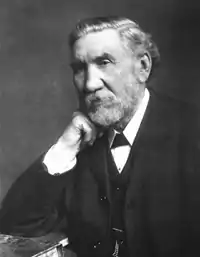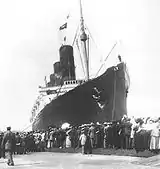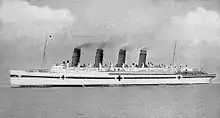James Howden
James Howden (29 February 1832 – 21 November 1913) was a Scottish engineer and inventor who is noted for his invention of the Howden forced draught system for steam boilers.
James Howden | |
|---|---|
 | |
| Born | February 29, 1832 |
| Died | 21 November 1913 (aged 81) |
| Nationality | Scottish |
| Occupation | Engineer and inventor |
| Parents |
|
Life
Howden was born in Prestonpans, East Lothian, in 1832,[1] the son of James Howden and his wife, Catherine Adams,[2] and was educated at the local parish school.[3] His first marriage was to Helen Burgess Adams, and his second to Allison Moffat Hay, with whom he had two sons and a daughter.[2] His two wives both predeceased him,[2] and he died in Glasgow in 1913.[1]
Career
Howden served as an apprentice from 1847 with James Gray & Co., a Glasgow engineering firm,[1][4] passing through the various departments and eventually becoming chief draughtsman.[3] Having finished his apprenticeship he started work first with Bell and Miller, the civil engineers, then with Robert Griffiths, who designed marine screw propellers.[1]
In 1854 Howden launched himself as a consultant engineer and designer, his first major invention being a rivet-making machine. The selling of the patent rights to a company in Birmingham[2] for this secured him financially and James Howden & Co. was established as a manufacturer of marine equipment.[1] In 1857 Howden began work on the design and supply of boilers and steam engines for the marine industry;[5] his first contract was with Hendersons to supply the Anchor Liner Ailsa Craig with a compound steam engine and water boilers, using steam at 100 lb pressure.[1][2] That same year, together with Alexander Morton of Glasgow, he was awarded a patent for the "invention of improvements in obtaining motive power."[6] On 28 February 1859 he applied for a patent for the "improvements in machinery, or apparatus for cutting, shaping, punching, and compressing metals."[7] In 1860 he patented a method of preheating combustion air;[5] his patent was granted for the invention of "improvements in steam engines and boilers, and in the apparatus connected therewith".[8] In 1862 he decided to construct main boilers and engines to his own design and started manufacturing in his first factory on Scotland Street in Glasgow's Tradeston district.[9] A breakthrough came in 1863 when he introduced a furnace mechanical draught system which used a steam turbine driven axial flow fan.[5]

Howden is chiefly remembered as the inventor of the Howden forced draught system, which forced heated waste gases into the combustion chamber by means of a fan and ductwork and which appeared in the 1880s.[4] This system dramatically reduced the amount of coal used in ships' boilers. Howden patented this device in 1882 as the 'Howden System of Forced Draught'[5] and during the 1880s more than 1000 boilers were converted to this specification or constructed to Howden's patent.[9] The first vessel to use the system was the New York City, built in 1885.[1] Amongst the liners to use the Howden system in their boilers were the Lusitania[10] and Mauretania,[10] the fastest liners in the world when they were built.
Howden's original Glasgow factory being too small for his expanding operation, he had a new, larger one designed by Nisbet Sinclair at 195 Scotland Street, down the road from his original factory. This opened in 1898 and featured overhead cranes, handling equipment and central-heating (a rarity at the time).[9] As a result of an overflowing order book, the factory was enlarged, first in 1904, and again in 1912, to a design by Bryden & Robertson.[9] As of 2009, this redbrick factory – "one of the last remaining Victorian heavy engineering works in Glasgow", and the place where the tunnel boring machines used in the excavation of the Channel Tunnel were made[9] – lies empty.

In the 1900s Howden designed a fully enclosed high-speed marine steam engine. This was later modified for use in land-based systems as the Howden-Zoelly steam turbine.[1] At the onset of the First World War, a year after Howden's death, the Admiralty ruled that all ships were to be fitted with Howden "blowers" so that they could outrun U-boats.[9]
Amongst the projects that Howden worked on were assisting the St Helena Whaling Company, quarrying marble in Greece and working on the design of a recoilless gun for the Admiralty.[1]
Howden was the last surviving founder member of the Institution of Engineers and Shipbuilders in Scotland, founded in 1857.[1] Although he was a lifelong Liberal, he took no part in politics or public life.[3]
Bibliography
- Munn, C. W. "James Howden", Dictionary of Scottish Business Biography, vol. 1, Aberdeen, 1986
- Obituary of James Howden, The Engineer, 28 November 1913
References
- Day, Lance and McNeil, Ian, Biographical Dictionary of the History of Technology, vol. 39, London, Routledge, 1988, p. 358, Biographical Dictionary books.google.com, accessed 27 September 2009
- Biography of James Howden graceguide.co.uk, accessed 28 September 2009
- Payne, Peter L., Studies in Scottish Business History, London, Taylor & Francis, 2006, p. 285, Studies in Scottish Business History books.google.com, accessed 28 September 2009
- Collins Encyclopaedia of Scotland, ed. Keay, J. and J., London, HarperCollins, 1994, p. 524
- History of the Howden Group howden.com, accessed 27 September 2009
- London Gazette, December 18, 1857 london-gazette.co.uk, accessed 3 October 2009
- London Gazette, March 29, 1859. london-gazette.co.uk, accessed 3 October 2009
- London Gazette, December 14, 1860 london-gazette.co.uk, accessed 4 October 2009
- History of Howden & Co. scottisharchitecture.com, accessed 28 September 2009
- Historic Environment Scotland. "191,193,195,197,199 Scotland Street, former Howden's Works (Category B Listed Building) (LB33533)". Retrieved 20 March 2019.